|
|
History of EFMC
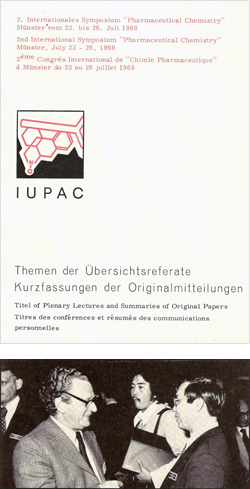 The series “International Symposium on Medicinal Chemistry” (ISMC), organized under the sponsorship of the EFMC, is older than the EFMC itself. This seems to be somewhat odd, but has everything to do with the originally rather loose structure of the federation (see part II of this annotations in MedChemWatch, April 2009). The official birthdate of the EFMC is 13 September 1972, following a decision which was reached on 19 December 1969, but a meeting organized by the Società Italiana Farmaceutiche in Firenze in 1962 is considered as the first symposium in the series, followed by a meeting in Münster (1968) as the second ISMC. Remarkably this meeting in Münster had been set up and organized by the Division of Organic Chemistry and the Division of Applied Chemistry of the IUPAC; our young discipline had not yet received the IUPAC’s full attention. A special feature of the Münster symposium was the acceptance of English, French and German as official languages, offering a simultaneous translating of the lectures, also from Russian, into the three languages. The series “International Symposium on Medicinal Chemistry” (ISMC), organized under the sponsorship of the EFMC, is older than the EFMC itself. This seems to be somewhat odd, but has everything to do with the originally rather loose structure of the federation (see part II of this annotations in MedChemWatch, April 2009). The official birthdate of the EFMC is 13 September 1972, following a decision which was reached on 19 December 1969, but a meeting organized by the Società Italiana Farmaceutiche in Firenze in 1962 is considered as the first symposium in the series, followed by a meeting in Münster (1968) as the second ISMC. Remarkably this meeting in Münster had been set up and organized by the Division of Organic Chemistry and the Division of Applied Chemistry of the IUPAC; our young discipline had not yet received the IUPAC’s full attention. A special feature of the Münster symposium was the acceptance of English, French and German as official languages, offering a simultaneous translating of the lectures, also from Russian, into the three languages.
It is not easy to explain why an international medicinal chemistry meeting announced as a “European Meeting on Medicinal Chemistry” organized in Brussels in 1970 by a consortium of national organizations from Belgium (both Wallonia and Flanders), France, Germany, Italy, The Netherlands and the UK, has never been designated as the ISMC III. Indeed the name International Symposium on Medicinal Chemistry, with the addition “number III”, was organized by the Division of Organic Chemistry of the IUPAC, in Milan in 1972. It is somewhat difficult to understand why the symposium organized with one of the founding fathers of the EFMC, Pietro Pratesi, as chairman of the organizing committee, did not have the EFMC as co-organizing body. In the Opening Remarks of the symposium Pratesi expressed thanks only to the IUPAC and the Associazione Industrie Chimico Farmaceutiche, without mentioning the EFMC or the Societa Italiana di Scienze Farmaceutiche. Clearly the EFMC was either still in a nascent form or was not generally accepted as an international body; the IUPAC remained the leading organization, and still considered medicinal chemistry as a special branch of organic chemistry. More information on the interactions between IUPAC and EFMC has been presented in number II of these annotations.
In 1972 the EFMC decided (after consulting the IUPAC!) to organize in all even years an International Symposium on Medicinal Chemistry, ISMC. The Dutch “Section Pharmacochemistry of the Royal Netherlands Chemical Society accepted to organize this IVth ISMC in 1974. The meeting was organized in conjunction with Belgian colleagues from Flanders and took place in Noordwijkerhout. The chair of the organizing committee was Wijbe Nauta, one of the founding fathers of the EFMC, who for many years has been the secretary of its Executive committee.
It seems that the symposium in Noordwijkerhout firmly established the ISMC series. The number of “active participants was still somewhat limited, (325 with an extra about 70 “accompanying participants”), but the fifth ISMC in 1976 in Paris – again with a founding father, Jean Thuillier, as chairman – attracted not less than 625 scientists, coming from twenty nine different nations. At that time posters became en vogue and over a hundred were on show in Paris. At this meeting John Topliss introduced his “manual method for applying the Hansch approach to drug design”, which later became widely known as “the Topliss tree”.
In 1978 the sixth ISMC was hosted by the British Society for Drug Research. The venue was Brighton, with John Cavalla (who has served on the EFMC for several years as chairman of the Executive Committee) as the chairman of its Organizing Committee. At this meeting double Nobel laureate Linus Pauling presented his remarkable ideas about the use of mega doses of vitamin-C to prevent cancer. Much attention was given to the new developments in the field of histaminergic H2 ligands; the first H2 antagonist was on its way to become a blockbuster as the anti-ulcer medicine, Cimetidine/Tagamet.
The seventh ISMC, originally scheduled to take place in 1980 in Madrid eventually took place in the Torremolinos, amidst a large number of sun-seeking tourists. The reason of the unexpected move from Madrid was that the Spanish government had used its power to force the organizers to vacate the booked facilities in Madrid which it needed for hosting a European meeting related to Spain’s recent entry of the European Union. Despite the somewhat unusual venue, the meeting in Torremolinos became a success, with about seven hundred participants from thirty four countries and a poster session with over two hundred posters. The chairman of the organizing committee was R. Madroňero. The famous medicinal chemist Alfred Burger presented a plenary lecture entitled “Current options in drug design”.
Due to a special request from colleagues in North America, the EFMC did not organize an ISMC in 1982. The medicinal chemists of Canada, Mexico and the USA had scheduled a North America Medicinal Chemistry Symposium in Toronto and apparently feared competition from a European meeting in the same year. At this symposium, chaired by Leslie Humber, a conflict emerged between the EFMC and the IUPAC (see previous annotations) and an International Committee on Medicinal Chemistry (ICMC) was founded. This committee was dissolved again in the late 1980s.
Uppsala Sweden was the hosting city of the eighth ISMC in 1984. Richard Dahlbom and Lars Nilsson chaired the symposium; the latter was at the time also chairman of the EFMC. The growth of the ISMC continued: about eight hundred participants from not less than thirtyfive countries. The programme consisted of eighteen symposia, and more than two hundred posters were presented. A special event was the inaugural lecture of Nobel laureate Bengt Samuelsson on “Chemistry and Medicine: Lessons from Prostaglandin and Leukotriene Research”, at that time a very hot topic. At this symposium the meaning of receptor classification became very apparent; many examples of selective ligands for subclasses of receptors were presented. It was also the time that the first relatively safe viricidal compounds showed up, as presented by Erik de Clercq from Leuven, Belgium.
The 1986 (ninth ISMC) meeting was special for its location, the western part of Berlin. The iron curtain was still down and “the wall” very much present. The chairman of the meeting was Ernst Mutschler, who had served the EFMC as chairman of the Executive Committee during the seventies. During the Berlin meeting omeprazole was presented as a promising new anti-ulcer agent; we all know now that the promises became fulfilled over the years to come. The important progress in anti-virus research was reviewed, as in Uppsala, by De Clercq.
For the tenth ISMC (1988), the EFMC had selected Budapest as a venue. The chairman, Laszlo Pallos, welcomed about seven hundred participants from twentyfive countries. This somewhat low number of participants was probably caused by the uncertain political situation of the time; however, no such tension was felt during the symposium. It was in the Budapest ISMC that the search for anti-HIV medicines was discussed (De Clercq), HIV becoming recognised as an emerging problem. The approach was rather empirical, starting from known viricidal ligands. Much attention was given to the use of computer modelling in drug design; this approach was seemingly taking over the role of QSAR technologies.
The 11th ISMC will always be remembered as a very special one. It took place in Jerusalem, and was organized by Shalom Sarel, Israel Agranat and Raphael Mechoulam. At the time of the final preparations for the symposium, the 1990 Gulf war began in August. Many already-registered participants decided to cancel their travel to Jerusalem. Finally not more than two hundred and fifty medicinal chemists from twenty countries convened; “industrialists” and Americans in particular decided not to attend. During the meeting there was much tension.
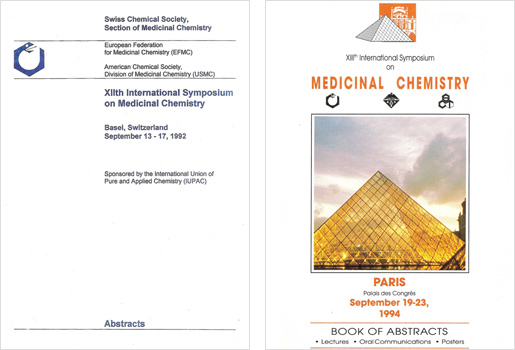
Basel was the host city of the 12th ISMC, Emil Kyburz, who has served the EFMC for a lengthy period as secretary and chairman of the Executive board, chaired the symposium. The number of attendants was back to normal, indeed even higher than before, with almost a thousand medicinal chemists present.
At this meeting the first EFMC award was installed. On an initiative of the Dutch, and financed by the Prof. Dr. W. Th. Nauta Foundation, the Nauta Award was presented for the first time. The award is given in recognition of excellence in medicinal chemistry and /or contributions to stimulate international contacts between medicinal chemists. The first winner was Arne Brandstrom (Astra Zeneca, Sweden) for his contributions to the design and development of the first successful proton pump inhibitor, omeprazole.
In 1994 Paris hosted the ISMC for the second time. The 13th symposium was chaired by Jaen-Claude Muller, who has served the EFMC as chairman of the Executive Committee. With over a thousand participants the ISMC was clearly still growing. The Nauta Award was granted to Maurice Petitou, for his important contributions to the role of sugar-chemistry in medicinal chemistry and especially the design and synthesis of low molecular-weight heparin derivatives (pentasaccharides).
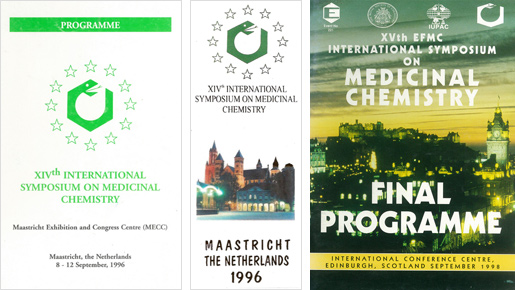
The 14th ISMC also had a special character. It was organized in Maastricht, in the Southern part of the Netherlands, a provincial town. The special feature was that the meeting was organized by the adhering organizations from Belgium and the Netherlands.
The chairmen were Achiel Haemers (B) and Henk Timmerman (NL). Over a thousand scientists participated; the size of the ISMC symposia seemed to have now found more or less a stable position and had become the largest “solo” medicinal chemistry symposium worldwide, not being part of a big international event (such as the ACS conferences during which medicinal chemistry meetings are organized). In Maastricht, Povl Krogsgaard Larssen was honoured with the third Nauta Award for his entire body of work and contributions to the field of medicinal chemistry.
Number fifteen (1998) of the ISMC series was hosted by British colleagues in Edinburgh, Scotland. The organizing bodies were the Biological & Medicinal Chemical Section of the Royal Society of Chemistry, the Royal Society of Chemistry and the Society for Chemical Industry. The organization started with Malcolm Campbell as chairman, but when he fell ill towards the time of the meeting, Derek Buckle took over his role.
The normal number of participants for the time of just above 1000 was realized. Henk Timmerman, Amsterdam, received the Nauta Award, for both his scientific achievements and his contributions towards fostering cooperation between medicinal chemists, in Europe especially.
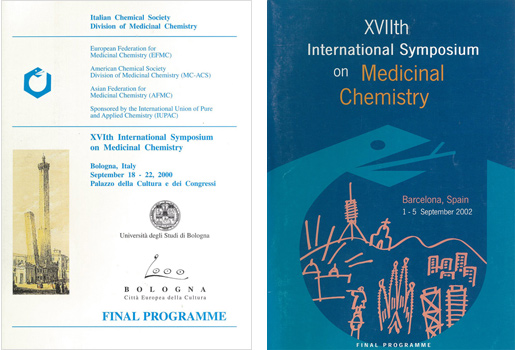
In the year 2000 the sixteenth ISMC was organized in Bologna. Carlo Melchiorre was chair of the organizing committee. Again more than 1000 medicinal chemists attended, confirming that the ISMC had definitively become the largest medicinal chemistry meeting worldwide. The Nauta award was granted to Erik de Clercq from Leuven, Belgium, for his major contributions to the identification of new, effective, and relatively safe, anti-viral compounds.
Due to the growing success of the ISMCs the adhering bodies of the EFMC became eager to organize an ISMC, whereas during the early years it had been sometimes difficult to interest a national organization to organize the next symposium. Now the adhering organizations started to compete, “bidbooks” appeared, and local tourist organizations started to show interest.
The ISMCs had always been organized under the full responsibility of the local organizers. In several cases the EFMC was not the sole “sponsoring” body of the given ISMC, and the IUPAC and the ACS had been involved in the same manner. As the EFMC grew more and more into a professional organization, despite serious financial constraints, plans were developed to bring the ISMCs completely under the EFMC umbrella. It was thought that the ISMC could bring incomes to the EFMC. However to realize this, responsibility for the financial outcome would need to be accepted and risks would be unavoidable. Changes could only be introduced step by step, especially as the federation had insufficient financial means to accept risks. A system was introduced by which the local organizer still took the full responsibility for the financial outcome; new was that the programme needed an acceptance by the EFMC-EC and when a profit was made the organizer should pay a fee per participant to the EFMC. This system was refined during the first decade of the new century. The ISMCs started to improve the financial health of the federation, which in due time may allow it to accept also a certain financial responsibility for an ISMC.
Barcelona hosted the seventeenth ISMC, with Ferran Sanz (who served the EFMC as president) as chairman of the organizing committee. The meeting was a major success. Now well over a thousand participants led to an interesting financial success for the EFMC.
Bernard Testa from Lausanne, Switzerland, was the awardee of the Nauta Prize for his major contributions to medicinal chemistry, including studies in pharmacokinetics in drug research. At this meeting the newly established UCB Award for excellence in medicinal chemistry (sponsored by UCB and later renamed into The UCB-Ehrlich Award
for Excellence in Medicinal Chemistry) was granted to Jürg Zimmermann (Novartis , Basel) for his role in the design and development of the kinase inhibitor imatinib (Glyvec/Gleevec).
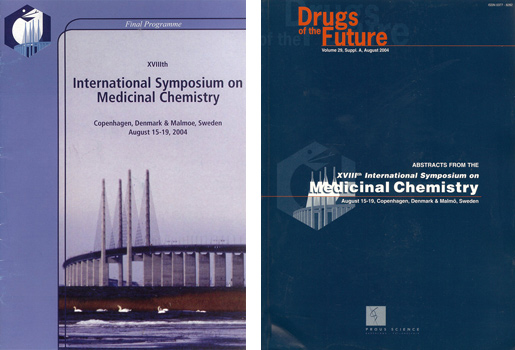
Povl Krogsgaard Larssen chaired the organizing Committee of the next ISMC (2004), which was co-organized by the Danish and Swedish medicinal chemistry organizations. For the major part the symposium took place in Copenhagen, but for one day the participants were moved to Lund in Sweden, passing the newly opened bridge between Denmark and Sweden. The symposium again attracted well over a thousand colleagues and was very successful.
Robin Ganellin (London) was honoured with the Nauta prize, especially for his major contributions in designing and developing the first clinically applied histamine H2 blocker, cimetidine (Tagamet). The UCB award was granted to Jesper Wengel of the University of Southern Denmark, for his discovery of “locked nucleic acids”, which provided important enhancements to the development of oligonucleotide based therapeutics.
Also at this meeting a new award was introduced, the Prous Award for new technologies in drug discovery (sponsored by the Prous Institute for Biomedical Research and later renamed the The Prous Institute-Overton and Meyer Award for New Technologies in Drug Discovery). The first recipient of this prize was C. Oliver Kappe, from Graz, Austria, for his achievements in the field of microwave assisted combinatorial chemistry.
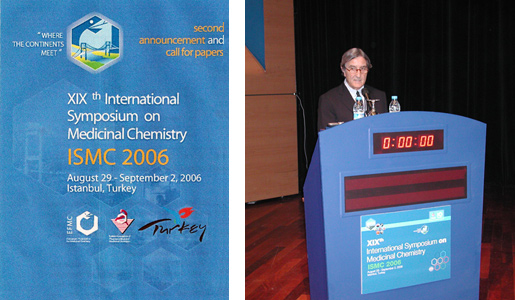
In 2006 the nineteenth ISMC was hosted by Turkish medicinal chemists in beautiful Istanbul at the Bosporus. The organizing Committee was chaired by Fethi Sahin. The number of participants was a bit lower than at previous ISMCs, likely due to some fear of the political unrest in Turkey. The Nauta Award was presented to Philip Portoghese of Minneapolis for his complete oeuvre and especially also his achievements as editor of the Journal of Medicinal Chemistry. Bernd Riedl (Bayer, Leverkusen) received the UCB-Ehrlich Award for his outstanding contributions to the discovery of the kinase inhibitor sorafenib (Nexafar). The Prous Institute-Overton Meyer Prize was awarded to Dario Neri (Zürich) for his pioneering and promising studies into the preparation of synthetic antibodies.
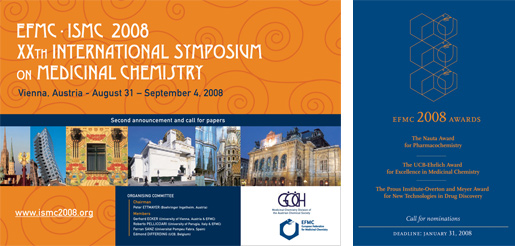
The twentieth ISMC was held in Vienna in 2008. The organizing committee was chaired by Peter Ettmayer. The number of participants was higher than ever before, around one thousand four hundred, from fifty nine nations. The organizers had succeeded to bring some of the atmosphere of the old glory of Vienna to the meeting by organizing social events in historically attractive locations, such as the famous Hofburg.
Prof Hugo Kubinyi (Heidelberg) was the winner of the 9th Nauta Award, being praised for the development, application and dissemination of rational drug discovery processes. Peter Seeberger (Zürich) received the UCB-Ehrlich Award for his excellent contributions to the automation of oligosaccharide synthesis, and Steven Ley was honoured with the Prous Institute-Overton Meyer Prize, to acknowledge his commitment to the discovery and introduction of new technologies for drug discovery.
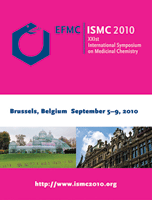 So far twenty ISMCs have been organized and the series is well established. Over the years cooperation with other scientific bodies (Div.Med. Chem ACS, Asian Fed. Med. Chem. EUFEPS) has emerged and joint sessions at each other’s symposia have resulted. So far twenty ISMCs have been organized and the series is well established. Over the years cooperation with other scientific bodies (Div.Med. Chem ACS, Asian Fed. Med. Chem. EUFEPS) has emerged and joint sessions at each other’s symposia have resulted.
The future for the ISMC is bright. The organizing of number XXI is well underway and is scheduled to take place in Brussels in 2010.
Published proceedings of ISMCs
- P. Pratesi, Medicinal Chemistry –III, Third International Symposium on Medicinal Chemistry, Milano 1972, two volumes; Butterworths, London
- J. Maas, Medicinal chemistry IV, Proceedings of the 4th International Symposium on Medicinal Chemistry, Noordwijkerhout (NL) 1974, Elsevier, Amsterdam
- J. Mathieu, Medicinal Chemistry V, Proceedings of the 5th International Symposium on Medicinal Chemistry, Paris 1976, Elsevier, Amsterdam
- A.Simkin, Medicinal chemistry VI, Proceedings of the 6th International
Symposium on Medicinal Chemistry, Brighton (UK) 1978, Cotswold Press
- Federico G. de las Heras and Salvador Vega, Medicinal Chemistry Advances,
Proceedings of the Seventh International Symposium on Medicinal chemistry, Pergamon, Oxford.
- Richard Dahlbom and J Lars G Nilsson, VIIIth International Symposium on
Medicinal chemistry, Uppsala (Sweden) 1984, Proceedings, two volumes, Swedish Parmaceutical Press Stockholm.
- E.Mutschler and E. Winterfeldt, Trends in Medicinal Chemistry, Proceedings of the Ninth International Symposium on Medicinal Chemistry, Berlin 1986, VCH Weinheim
- H.van der Goot, G.Domány. L.Pallos and H. Timmerman, Trends in Medicinal
Chemistry “88, Proceedings of the Xth International symposium on Medicinal Chemistry, Budapest 1988, in Pharmacochemistry Library12, H. Timmerman, Ed. Elsevier Amsterdam
- Shalom Sarel. Raphael Mechulam and Israel Agranat, “Trends in Medicinal
Chemistry’90; (proccedings of the XII ed ISMC Jerusalem 1990), Blackwell
London 1992.
- Jean- Claude Muller, Proccedings of the XIIIth ISMC, Supplement to the
Europ.J.M. , 30 1995
- M.M. Campbell and I.S. Blagbrough, Medicinal Chemistry into the Millennium,
Proceedings XIVthe ISMC Edinburgh, RSC , (2001)
- Il Farmaco (2001), 51. 1-2, Proceedings of the XVth International Symposium on Medicinal chemistry, Bologna, Italy, Guiseppe Ronsisvalle, Editor;(selected lectures)

Note: I have written this review partly from documents, partly from my memory (I attended all but one ISMC). It is quite possible I introduced some incorrect data or have forgotten interesting aspects. I invite the readers to contact me in case they like to propose adjustments, additions, improvements.
Henk Timmerman
Address of the author:
Henk Timmerman
Wijttenbachweg 73
2343XX Oegstgeest, the Netherlands
tel: + 31 (0) 71 5762 791
mob: + 31 (0) 6 1344 55 54
fax: +31 (0) 71 364 56 65
e-mail: henktim@planet.nl
|
|

Editor
Gabriele Costantino
Univ. Parma, IT
Editorial Committee
Erden Banoglu
Gazi Univ., TR
Leonardo Scapozza
Univ. of Geneve, CH
Wolfgang Sippl
Univ. Halle-Wittenberg, DE
Kristian Stromgaard
Univ. Copenhagen, DK
Mark Lansdell
Pfizer, UK

Executive Committee
Gerhard Ecker President
Roberto Pellicciari Past-Pres.
Koen Augustyns Secretary
Rasmus P.Clausen Treasurer
Javier Fernandez Member
Mark Bunnage Member
Peter Matyus Member

|









